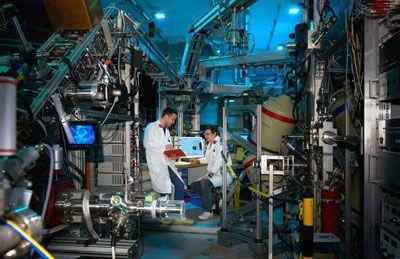
Batteries, the cathode consists of a mixture of nickel, manganese, cobalt and lithium, are currently considered the most efficient. But they have a limited lifespan. From the first cycle they lose up to 10% of their capacity. Why is that and what can be done against the subsequent gradual loss of capacity, now has explored an interdisciplinary team of scientists at the Technical University of Munich (TUM) using positron accurate.
So-called NMC batteries, whose cathodes consist of a mixture of nickel, manganese, cobalt and lithium, have largely pushed conventional lithium-cobalt oxide batteries off the market. They are cheaper and safer and are therefore used in electric and hybrid cars, among other things. But even with them, only a little more than 50% of the lithium atoms contribute to the actual capacity. While 62% of the lithium atoms could still be detached from the crystal lattice during the first discharge of the electrodes examined at the Technical University of Munich, only 54% return when they are recharged.
In the subsequent cycles, the loss is much lower, but the capacity gradually decreases gradually. After a few thousand cycles, the remaining capacity is so low that the battery becomes unusable.
Captured positrons show holes in the grid
Investigations by other groups showed that not all lithium atoms find their way back into the appropriate gaps in the crystal lattice during charging. However, previous methods could not show the atomic processes responsible for this. As is so often the case, the solution came from interdisciplinary cooperation: Irmgard Buchberger, who works at the Chair of Technical Electrochemistry at the Technical University of Munich, contacted Stefan Seidlmayer, who is also researching battery technologies at the FRM II research neutron source at the Heinz Maier-Leibnitz Zentrum (MLZ). .
He arranged contact with Christoph Hugenschmidt, who is in charge of the Nepomuc instrument at the MLZ. It generates positrons, the antiparticles of the electrons, which can be used to specifically search for holes in crystal lattices. “As extremely small and highly mobile particles, positrons can fly through materials. If they hit an electron, they immediately end up in a flash of energy, if they find an empty spot in the crystal lattice, they survive much longer,” explains Markus Reiner, who carried out the experiments on the Nepomuc instrument.
Since the positrons are trapped in the empty lattice sites for a short time before finally blasting, positron annihilation spectroscopy can be used to draw precise conclusions about the local environment - and this with a very high sensitivity, as it is possible to find flaw concentrations of up to to 1: 10 million detect.
Targeted material development
The study clearly shows that "holes" remaining in the grid of the cathode material during recharging are associated with the irreversible loss of capacity and this blockage is due to the insufficient filling of the holes in the cathode material. "Now it's our turn as chemists again," says Prof. Hubert Gasteiger, Chair of Technical Electrochemistry. "By specifically modifying the cathode material, we can now look for ways to circumvent this barrier."
"For the Batteryresearch, the Garching research neutron source is an extremely helpful tool,” says Ralph Gilles, who coordinates the measurements for the 'Exzellum' battery research project at the FRM II. “With neutrons, we can see small atoms like lithium, in particular, well, even through the metal shell while the machine is in operation. With the positrons, we have now opened up another possibility to better understand the processes and thus to be able to further improve them.”
The research was supported by funds of the Federal Ministry of Education and Research (BMBF) within the framework of the project Exzelltum. The operation of the Coincident Doppler Broadening Spectrometer used for the study will also receive funding from the BMBF.